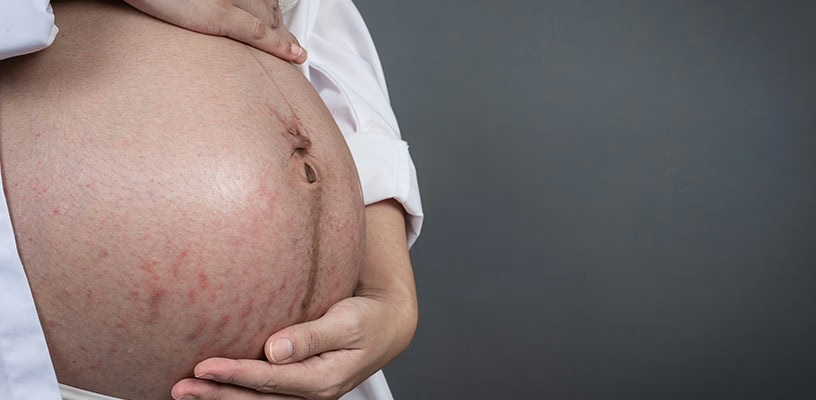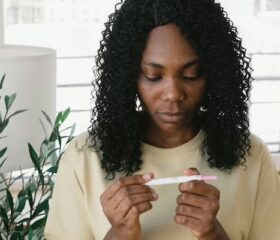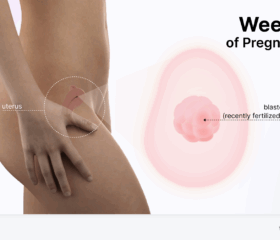PUPPP Rashes in Pregnancy: Diagnosis, Causes, and What to Do About Them
What’s worse than pregnancy cravings and morning sickness? For some women, it’s the intense rashes caused by PUPPP.

If you’re dealing with an itchy, red rash during pregnancy, you might have this condition. PUPPP, which stands for “pruritic urticarial papules and plaques of pregnancy,” is also known as polymorphic eruption of pregnancy (PEP) and Nurse’s late onset prurigo.
Regardless of the name, it’s a common but frustrating condition that affects many expectant mothers. Read on to learn more about what you can expect with this condition and how you can treat it at home.
What is PUPPP rash?
PUPPP rash is one of the most common pregnancy-related skin conditions, affecting every 1 in 160–300 pregnancies. 1
You’re more likely to experience it during the third trimester—especially in the last five weeks when your baby bump is the biggest—but it can sometimes occur earlier, or even postpartum. 2
The good news is that PUPPP won’t harm you or your baby, although the itching may be uncomfortable. Normally, it goes away on its own, usually within four to six weeks of delivery. Fortunately, you’re less likely to get it again during your next pregnancy. 3
What does PUPPP rash look like?
A PUPPP rash usually starts with small, raised bumps in the stretch marks on your abdomen, which can then spread to form larger, hive-like patches called plaques. Your rashes may either be red or a little darker than your normal skin tone.
You may develop blisters or target-shaped and eczema-like lesions with red or dark centers, surrounded by paler haloes. 4 5
Your rash may spread from your stomach to your arms, thighs, buttocks, breasts and even back. It usually won’t affect the area around your belly button or leave scarring once you heal. 6 7 8
While PUPPP rashes can be itchy, never scratch them, as this can cause infection.
Note that, if you break out on your face, palms, or the soles of your feet, this could be a sign of another skin condition, and you should contact your doctor.
What causes PUPPP rashes?
While the exact cause of PUPPP remains unknown, several theories exist. One is that they might be caused by an autoimmune response to either: 8 1
- Fetal cells: Some of your baby’s DNA can settle in your skin, most often during the third trimester, particularly in areas of your skin with increased blood flow or damaged collagen. This can cause an immune reaction.
- Your own collagen: Since this type of rash starts in the damaged tissue in your stretch marks and spreads to other parts of your body, some doctors believe it might be your body’s immune system reacting to collagen (even in areas of healthy skin).
It’s also possible that PUPPP rashes are caused by hormones. During pregnancy, your progesterone levels spike, especially if you’re carrying multiple babies, which may affect your skin and trigger rashes.
Risk factors for PUPPP rashes
Although exactly why PUPPP rashes develop is unknown, several factors increase your risk of getting one: 8 1
- Rapid weight gain: You’re more likely to experience PUPPP if you gain a lot of weight during pregnancy. As your bump grows, your skin stretches quickly, especially if you’re carrying multiple babies, damaging the connective tissues in your stretch marks and triggering inflammation.
- Carrying multiples: As mentioned, you’re more likely to experience PUPPP if you’re carrying more than one baby, such as twins (which increases your chance of getting a rash by 2.9%–16%) or triplets (14–17%).
- First pregnancy: Being a first-time mom makes you more likely to develop PUPPP (75% of cases occur in first-timers).
- Baby gender: If you’re expecting a boy, the likelihood of you developing PUPPP is twice as high, with a male-to-female ratio of 2 to 1.
When should you talk to your doctor about your rash?
PUPPP rashes aren’t dangerous and don’t always require medical treatment. However, you should call your doctor if your rashes are severe enough to interfere with your sleep and daily life.
You should also seek medical attention if your symptoms don’t align with PUPPP, as outlined above, such as if you get rashes around your hands and feet or if you notice changes in your urine and stool.
Again, while your PUPPP rashes may resolve on their own, scratching them can cause infection. Avoid irritating them, and keep an eye out for signs like pus, pain, and swelling in the affected areas. If you have fever or chills, you should also go see your doctor.
How will your doctor diagnose your PUPPP rash?
If you do see your doctor, they’ll diagnose you after a physical examination and review of your medical history. They will assess your rash’s appearance, location, and associated symptoms to rule out other causes.
Potential other causes of rashes in pregnancy
As alluded to, PUPPP is sometimes confused with other pregnancy-related skin conditions, which include:
Pemphigoid gestationis (PG)
Pemphigoid gestationis (PG) has similar symptoms to PUPPP but is more serious. 9 It’s a rare skin condition that affects about 1 in 50,000 pregnancies in the US. It usually appears in the second trimester, but it can also occur at any point during your pregnancy or even shortly after delivery, like PUPPP.
However, unlike PUPPP, these rashes affect the soles of your feet and your belly button. They also may reappear the next time you get pregnant, have your period, or use oral contraception.
This condition also affects your baby, leading to lesions and blisters in mild cases. More severe cases may lead to preterm delivery. 10 If you suspect you have this type of rash instead of PUPPP, see your doctor.
Intrahepatic cholestasis of pregnancy (ICP)
If your itching is primarily on the palms and soles of your feet without a widespread rash, your doctor may order blood tests to check for cholestasis, also known as obstetric cholestasis.
This condition occurs late in pregnancy and affects the liver. Other symptoms include dark urine and light-colored stool, as well as yellow skin and eyes (jaundice). 11
Other conditions
Your doctor may inquire about any recent changes in your personal care products, detergents, or pregnancy diet that could cause an allergic reaction. They may also check to ensure you’re not reacting to anything in your environment (even to something as seemingly insignificant as insect bites) or whether you might be dealing with an infection.
To reiterate, if you have symptoms that are not consistent with PUPPP, contact your doctor immediately.
How can you treat a PUPPP rash?
Some PUPPP rashes are ignorable, but some can be intense enough to require management. 12
Treatments from your doctor
Your doctor will usually focus on relieving the itching and reducing inflammation with: 6
- Topical corticosteroids: Your doctor may prescribe a steroid cream or ointment—like hydrocortisone, desonide, or triamcinolone acetonide—to apply to the affected areas. 13
- Topical anti-itch treatment: They may also suggest anti-itch lotions or creams like Aveeno and Caladryl.
- Oral antihistamines: You can take Benadryl while pregnant, along with other over-the-counter antihistamines like Zyrtec and Claritin, if your doctor says it’s okay. Don’t take them on your own without consulting your doctor.
- Oral steroids: If your case is severe, your doctor may prescribe a short course of oral steroids like prednisolone or prednisone.
Always use these medications as directed to avoid unwanted side effects.
At-home remedies
In addition to medical treatments, you can try several home remedies to get relief from PUPPP. If your rash is particularly bad, none of these is a good substitute for an actual treatment from your doctor, but they won’t do any harm, and might provide some relief: 14
- Oatmeal baths: To avoid a mess, put about two handfuls (one cup) of oatmeal in a clean piece of lightweight fabric that isn’t woven—like a sock, washcloth or bandana—that you can soak in your bathtub or squeeze out over your skin in the shower.
- Baking soda baths: Similarly, you can add baking soda to your bathwater or mix it into a paste to apply to your rashes. This has certain health risks if you add too much, so talk to your doctor before trying it, and get their advice on how much baking soda you can use safely. 15
- Soap and lotion: If your skin is dry, itchy and inflamed, use pine tar soap or Sarna lotion.
- Cool compresses: Calm your skin down with cool, wet compresses.
- Aloe vera and witch hazel: If you need a soothing and moisturizing remedy, apply aloe vera gel or witch hazel extract on your rashes.
Beyond that, try updating your wardrobe. Wearing loose-fitting, soft cotton clothing can minimize irritation and allow your skin to breathe.
Final thoughts
While PUPPP rashes can be uncomfortable, this is a temporary condition that poses no threat to you or your baby. With proper management and a little patience, you can find relief from the itching and focus on the joy of welcoming your little one into the world.
Article Sources
- Access Medicine. "Chapter 77: Pruritic Urticarial Papules and Plaques of Pregnancy" Retrieved June 2, 2025.
- The Primary Care Dermatology Society. "Polymorphic eruption of pregnancy (syn. pruritic urticarial papules and plaques of pregnancy)" Retrieved June 2, 2025.
- Mount Sinai. "How to Manage Skin Rashes During Pregnancy" Retrieved June 2, 2025.
- NewYork-Presbyterian Hospital. "Pregnancy: Stretch Marks, Itching, And Skin Changes" Retrieved June 2, 2025.
- British Association of Dermatologists. "Polymorphic eruption of pregnancy" Retrieved June 2, 2025.
- StatPearls. "Dermatoses of Pregnancy" Retrieved June 2, 2025.
- American College of Obstetricians and Gynecologists. "Skin Conditions During Pregnancy" Retrieved June 2, 2025.
- StatPearls. "Pruritic Urticarial Papules and Plaques of Pregnancy" Retrieved June 2, 2025.
- StatPearls. "Pemphigoid Gestationis" Retrieved June 2, 2025.
- American Osteopathic College of Dermatology. "Pemphigoid Gestationis" Retrieved June 2, 2025.
- Tommy’s. "Itching in pregnancy" Retrieved June 2, 2025.
- Department for Health and Wellbeing, Government of South Australia. "Pruritic Urticarial Papules and Plaques of Pregnancy (PUPPP)" Retrieved June 2, 2025.
- American Osteopathic College of Dermatology. "Pruritic Urticarial Papules and Plaques of Pregnancy" Retrieved June 2, 2025.
- Treatment of Skin Disease (Fifth Edition). "Pruritic Urticarial Papules and Plaques of Pregnancy" Retrieved June 2, 2025.
- Medical News Today. "What are the benefits of a baking soda bath and how to do it" Retrieved June 2, 2025.







